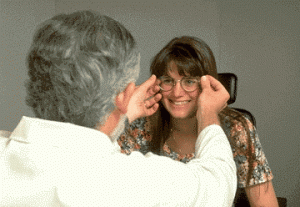
The numbers your Eye M.D. jots down during your eye exam describe what you’re seeing, and what you’re not seeing.
If you know how to read your prescription you can usually comparison shop for glasses over the phone, a good way to get a base price for the glasses of your choice. Don’t forget that you will probably want lens enhancements, which will be an additional cost.
Whether your Eye M.D. writes your eye glass prescription on a pre-printed form specifically for eye glasses or on a blank sheet of paper, the numbers will read the same. O.D. (oculus dextrus) is your right eye and O.S. (oculus sinister) is your left. You might see the abbreviations RE and LE, or possibly no designation at all. If that is the case, you can safely assume that the first set of numbers is for your right eye.
| Sphere | Cylinder | Axis | |
| O.D. | +2.50 | +1.00 | 180 |
| O.S. | +1.75 | +1.50 | 180 |
| +2.00 add |
The prescription above reads, “Right eye, plus two point five zero, plus one point zero zero, axis 180. Left eye, plus one point seven five, plus one point five zero, axis one eighty. Plus two point zero zero add.”
The “Sphere” column indicates how nearsighted or farsighted you are. “Cylinder” refers to the measurable degree of astigmatism of your central cornea. The cylindrical number describes the dioptric difference between your cornea’s steepest and lowest curves.
If you have astigmatism, your cornea is shaped like the back of a spoon, curved more on one side than the other. The orientation of the spoon shape can differ from person to person, for instance like a spoon standing on end or on it’s side. The “Axis” column describes the orientation in degrees from horizontal. Most left and right eyes with astigmatism are symmetrical.
What Do the Numbers Mean?
Lens power is measured in units called diopters. Diopters are based on the extent light rays passing through the lens will be bent. As the power of the lens increases, so does the thickness of the lens. There are three different types of lenses:
The prescription below reads, “Right eye, minus one point two five, minus two point five zero, axis ninety. Left eye, minus zero point seven five, minus two point two five, axis eighty-five.”
| Sphere | Cylinder | Axis | |
| O.D. | -1.25 | -2.50 | 90 |
| O.S. | -.75 | -2.25 | 85 |
| +1.50 add |
This means the patient’s right eye has 1 1/4 diopters of nearsightedness with 2 1/2 diopters of astigmatism. The axis refers to the orientation of the cylindrical area of the lens. The axis can be anywhere from 1 to 180 degrees, with 90 being the vertical meridian. The left eye has 3/4 diopters of nearsightedness, 2 1/4 diopters of astigmatism, axis 85.
Bifocal prescriptions are indicated with numbers such as the “+1.50 add” above.  This number indicates the strength of the lens. This patient will need 1 1/2 diopters of power for reading.
This number indicates the strength of the lens. This patient will need 1 1/2 diopters of power for reading.
Where’s the Best Bargain?
Once you do some calling around, it’s likely you’ll find the big chain stores that advertise great savings, such as two pairs of glasses for $39.99, aren’t offering the frames or enhancements that you’re looking for. It’s also likely you won’t get the service you expect either.